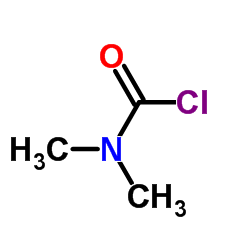dmcl

dmcl structure
|
Common Name | dmcl | ||
|---|---|---|---|---|
| CAS Number | 79-44-7 | Molecular Weight | 107.539 | |
| Density | 1.1±0.1 g/cm3 | Boiling Point | 166.8±0.0 °C at 760 mmHg | |
| Molecular Formula | C3H6ClNO | Melting Point | −33 °C(lit.) | |
| MSDS | Chinese USA | Flash Point | 68.3±0.0 °C | |
| Symbol |


GHS06, GHS08 |
Signal Word | Danger | |
|
Phenyldichlorophosphate as an aid in studies of decarbamylation of carbamylated acetylcholinesterase.
Anal. Biochem. 170(2) , 451-5, (1988) An improved method for assaying carbamylated acetylcholinesterase is described which has substantial benefits over current methods. Acetylcholinesterase was carbamylated with neostigmine and diluted extensively into buffer to allow decarbamylation to occur. A... |
|
|
Dimethylcarbamoyl chloride.
Rep. Carcinog. 12 , 171-2, (2011)
|
|
|
Dimethylcarbamoyl chloride.
Rep. Carcinog. 11 , III107, (2004)
|
|
|
Dimethylcarbamoyl chloride.
Rep. Carcinog. 10 , 106-7, (2002)
|
|
|
Dimethylcarbamoyl chloride.
IARC Monogr. Eval. Carcinog. Risks Hum. 71 Pt 2 , 531-43, (1999)
|
|
|
Inhalation carcinogenesis by dimethylcarbamoyl chloride in Syrian golden hamsters.
J. Environ. Pathol. Toxicol. 4(1) , 107-15, (1980) The comparative carcinogenicity of dimethylcarbamoyl chloride (DMCC) was studies in male, Syrian Golden Hamsters by inhalation. Hamsters were exposed to 1ppm and the exposure periods were 6 hours per day, 5 days per week for the lifetime of the animals. Fifty... |
|
|
Formation of 6-dimethylcarbamyloxy-dGuo, 6-dimethylamino-dGuo and 4-dimethylamino-dThd following in vitro reaction of dimethylcarbamyl chloride with calf thymus DNA and 6-diethylcarbamyloxy-dGuo following in vitro reaction of diethylcarbamyl chloride with calf thymus DNA.
Chem. Biol. Interact. 40(2) , 209-31, (1982) The rodent carcinogens dimethylcarbamyl chloride (DMCC) and diethylcarbamyl chloride (DECC) react with dGuo (pH 7.0-7.5, 37 degrees C, 4 h) to form the O6-acyl derivatives 6-dimethylcarbamyloxy-2'-deoxyguanosine (6-DMC-dGuo) and 6-diethylcarbamyloxy-2'-deoxyg... |
|
|
Detection of novel non-ras oncogenes in rat nasal squamous cell carcinomas.
Mol. Carcinog. 1(1) , 4-6, (1988) Rat nasal squamous cell carcinomas induced by inhalation of three direct-acting alkylating agents yielded DNA containing activated oncogenes with no homology to any member of the ras family. The novel NIH 3T3 transforming oncogenes from tumors induced by beta... |
|
|
Relationships between the levels of binding to DNA and the carcinogenic potencies in rat nasal mucosa for three alkylating agents.
Cancer Lett. 33(2) , 175-81, (1986) Three direct-acting carcinogens, beta-propiolactone (BPL), methylmethane sulfonate (MMS), and dimethylcarbamyl chloride (DMCC), were evaluated for their carcinogenic potencies in the nasal mucosa of rats and for their abilities to bind in vivo to rat nasal mu... |
|
|
Dosage limitations of the effects of difficult-to-detect carcinogens on in vitro interferon induction.
J. Interferon Res. 4(1) , 129-33, (1984) Several carcinogens have been shown to depress in vitro interferon (IFN) induction, while closely matched weakly or noncarcinogenic analogues had no effect on IFN induction. In this study, specific carcinogens that were difficult to detect by the Ames Salmone... |